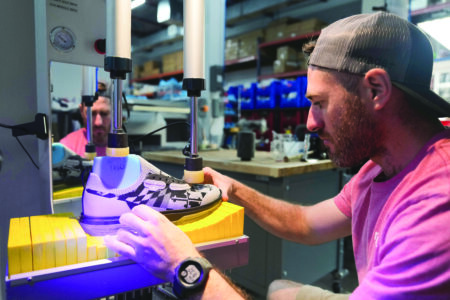Students investigate ‘lambicide’
Forensic anthropology techniques used in outdoor search

Northern Michigan University students, seen in this photo perform a line search in a simulated forensic investigation last Wednesday on the grounds of Teaching Family Homes of Upper Michigan. The activity was part of a forensic anthropology class. (Journal photo by Christie Bleck)
- Northern Michigan University students perform a line search in a simulated forensic investigation last Wednesday on the grounds of Teaching Family Homes of Upper Michigan. The activity was part of a forensic anthropology class. (Journal photo by Christie Bleck)
- Northern Michigan University students, seen in this photo perform a line search in a simulated forensic investigation last Wednesday on the grounds of Teaching Family Homes of Upper Michigan. The activity was part of a forensic anthropology class. (Journal photo by Christie Bleck)
Students from an NMU class combining forensic anthropology and criminal justice, AN/CJ 495, visited Teaching Family Homes of Upper Michigan, a youth residential facility located in Sands Township, last Wednesday to track down a “body,” which in this case was a stillborn lamb.
Wooded areas surround TFH, so this was a good place for them to process a crime scene, even if it was just a simulated one.
The objective of the class was to have the students perform investigative actions in a mock outdoor crime scene that involved all the students searching for animal remains. Once located, teams of five students were to process the scenes at which they were to locate, photograph, sketch and collect evidence for later analysis.
Each team was to submit a formal report that included a sketch and photographs and present a PowerPoint presentation on its findings.

Northern Michigan University students perform a line search in a simulated forensic investigation last Wednesday on the grounds of Teaching Family Homes of Upper Michigan. The activity was part of a forensic anthropology class. (Journal photo by Christie Bleck)
“The object is to bring people out and put them into a real-life situation where they can try some of the techniques and some of the skills that we’ve been trying to impart on them in the classroom,” said Robert Hanson, NMU associate professor of criminal justice.
The first part of the class involved looking for the deceased animal using a search pattern and compasses, he said, with individual mock crime scenes were set up.
This is the second time such a class was held.
“Last year, it was a foxicide,” Hanson said.
Hanson acknowledged an outdoors investigation is much more difficult because in a building it’s easy to make measurements from corners and doorways.
In the middle of a thick forest, it’s a bit more complicated.
So, Hanson said the students were to use a datum, which can be set using a compass or GPS.
“They’re going to be practicing all of those,” Hanson said. “They’re going to feel what it’s like to do a search, and this is the ideal setting.”
As with many field exercises, the outdoors activity had a different dynamic from a classroom.
“It’s one thing to talk about it and read about it,” Hanson said. “It’s another thing to get out, and it’s going to be a little chaos involved.”
Just like real life.
“The book has a very simple thing,” Hanson said. “The first person on the scene, the first responder on the scene, is going to make an assessment and decide what the boundaries of the crime scene are. Well, they don’t tell you, you know, 8.4 feet from the center of whatever you find. It goes by the circumstances.”
The class even was assigned a case number: ANCJ495-1810. It involved a collaborative effort between team members that included tasks such as note taking, taping off boundaries, taking photographs that included close-ups of evidence and placing markers at the evidence.
Members were to collect and secure evidence after photos and sketch locations were noted, and then recover flags, tape and any other material.
They also had to store evidence in a vehicle as directed.
Kaitlynn Cesarek, a third-year NMU student majoring in anthropology and international studies, said she has a longtime interest in ancient Egyptian culture.
That fueled her decision to study anthropology so she could take archaeology courses.
“Then the forensic program came up, and it’s like, ‘OK, oh, that’s kind of perfect’ because — mummies,” Cesarek said.
There weren’t any mummies on the TFG grounds Wednesday, but she could learn about another one of her interests: osteology, the study of bones.
And bones were some of the evidence the students found scattered on the grounds.
One of the program leaders at TFH was Scott Demel, NMU associate professor of sociology and anthropology, who said the popular class is at full capacity.
“You get real hands-on training and learning,” Demel said.
Wednesday involved search-and-recovery efforts, so the leaders entailed the help of Michael Neiger of Michigan Backcountry Search and Rescue.
Neiger had the students conduct a line search along a path and then walk slowly through the woods, scouring the area for bits of evidence.
He gave them a few pointers first, such as considering the fact that bodies can fall prey to predation from animals, with the small ones sometimes hiding their cache under evergreen trees.
Those are the types of spots they had keep an eye out for on their search.
“You’re not looking for a body,” Neiger said. “You’re looking for something that’s difficult to see.”
Those “somethings” were small bones hidden under fallen leaves, which when discovered were tagged with orange flags.
By the way, the lamb eventually was discovered.
Christie Bleck can be reached at 906-228-2500, ext. 250. Her email address is cbleck@miningjournal.net.







